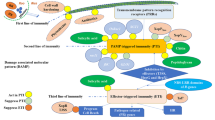Abstract
Resistance in the leaf blades of rice plants against a virulent race of the rice blast fungus Magnaporthe oryzae was quantitatively examined using a modified spot inoculation method. Numbers of conidia produced in the lesions were affected by plant age and paralleled the frequency of resistance infection types, which is indicative of whole-plant-specific resistance (WPSR), in the inoculated leaf sheaths of the corresponding plants. Exogenous abscisic acid treatment, which suppresses WPSR, also increased the susceptibility of the leaf blades. These results indicate a correlation between the resistance of the leaf blades and the WPSR in the leaf sheaths.



Similar content being viewed by others
References
Couch BC, Kohn LM (2002) A multi locus gene genealogy concordant with host preference indicates segregation of a new species, Magnaporthe oryzae, from M. grisea. Mycologia 94:683–693
Hashioka Y (1963) Effects of environmental factors on development of causal fungus, infection, disease development, and epidemiology in rice blast disease. In: The rice blast disease. Proceedings of a symposium at the international rice research institute, Johns Hopkins Press, Baltimore, MD, USA pp 153–161
Hoshikawa K (1989) The growing rice plant: an anatomical monograph. Nobunkyo, Tokyo
Jia Y, Valent B, Lee FN (2003) Determination of host responses to Magnaporthe grisea on detached rice leaves using a spot inoculation method. Plant Dis 87:129–133
Kato H, Yamamoto M, Yamaguchi-Ozaki T, Kadouchi H, Iwamoto Y, Nakayashiki H, Tosa Y, Mayama S, Mori N (2000) Pathogenicity, mating ability and DNA restriction fragment length polymorphisms of Pyricularia populations isolated from Gramineae, Bambusideae and Zingiberaceae plants. J Gen Plant Pathol 66:30–47
Koga H, Dohi K, Nakayachi O, Mori M (2004a) A novel inoculation method of Magnaporthe grisea for cytological observation of the infection process using intact leaf sheaths of rice plants. Physiol Mol Plant Pathol 64:67–72
Koga H, Dohi K, Mori M (2004b) Abscisic acid and low temperatures suppress the whole plant-specific resistance reaction of rice plants to the infection of Magnaporthe grisea. Physiol Mol Plant Pathol 65:3–9
Koh YJ, Hwang BK, Chung HS (1987) Adult plant resistance of rice to leaf blast. Phytopathology 77:232–236
Matsuyama N, Dimond AE (1974) Effect of nitrogenous fertilizer on biochemical processes that could affect lesion size of rice blast. Phytopathology 63:1202–1203
Ohata K, Goto K, Kozaka T (1966) Effect of low air temperature on the susceptibility of rice plants to blast disease, with special reference to some chemical components in the plants (in Japanese with English summary). Bull Natl Inst Agric Sci 20:1–65
Ou SH (1985) Blast–Pyricularia oryzae. In: Rice diseases, 2nd edn. Commonwealth mycological institute, Kew, UK, pp 109–201
Rusterucci C, Zhao Z, Haines K, Mellersh D, Neumann M, Cameron RK (2005) Age-related resistance to Pseudomonas syringae pv. tomato is associated with the transition to flowering in Arabidopsis and is effective against Peronospora parasitica. Physiol Mol Plant Pathol 66:222–231
Tanaka S, Yamada K, Yabumoto K, Fujii S, Huser A, Tsuji G, Koga H, Dohi K, Mori M, Shiraishi T, O’Connell R, Kubo Y (2007) Saccharomyces cerevisiae SSD1 orthologues are essential for host infection by the ascomycete plant pathogens Colletotrichum lagenarium and Magnaporthe grisea. Mol Microbiol 64:1332–1349
Yokoo Y (1983) Near-isogenic lines of rice with respect to a Pi-z t gene for resistance to blast disease. Jpn J Breed 33:341–345
Acknowledgement
We thank Dr. M. J. Christensen (AgResearch, Grasslands Research Centre, New Zealand) for critically reviewing the manuscript.
Author information
Authors and Affiliations
Corresponding author
Rights and permissions
About this article
Cite this article
Koga, H., Dohi, K., Yoshimoto, R. et al. Resistance in leaf blades assessed by counting conidia correlates with whole-plant-specific resistance in leaf sheaths in a compatible rice–Magnaporthe oryzae interaction. J Gen Plant Pathol 74, 246–249 (2008). https://doi.org/10.1007/s10327-008-0091-7
Received:
Accepted:
Published:
Issue Date:
DOI: https://doi.org/10.1007/s10327-008-0091-7




